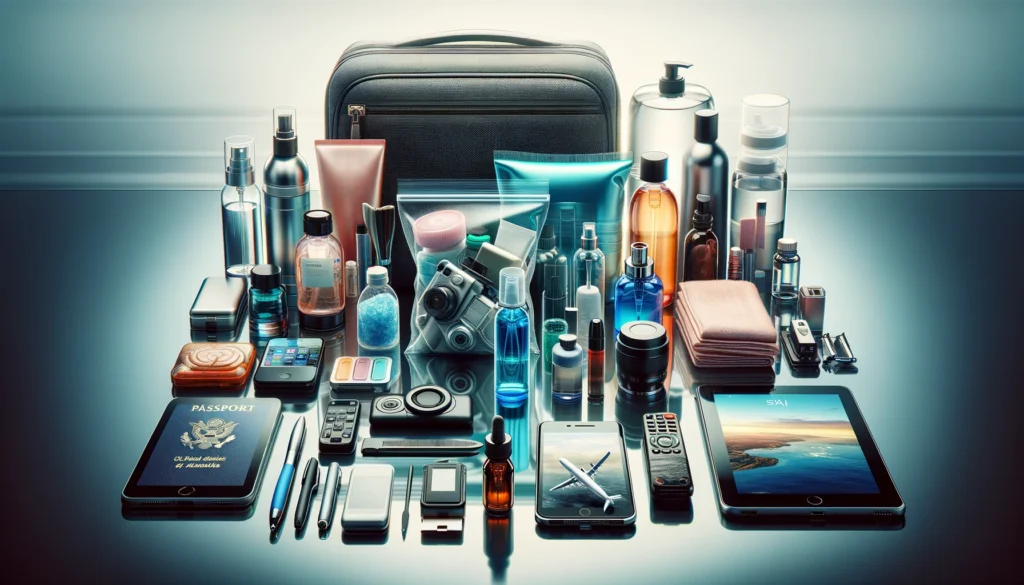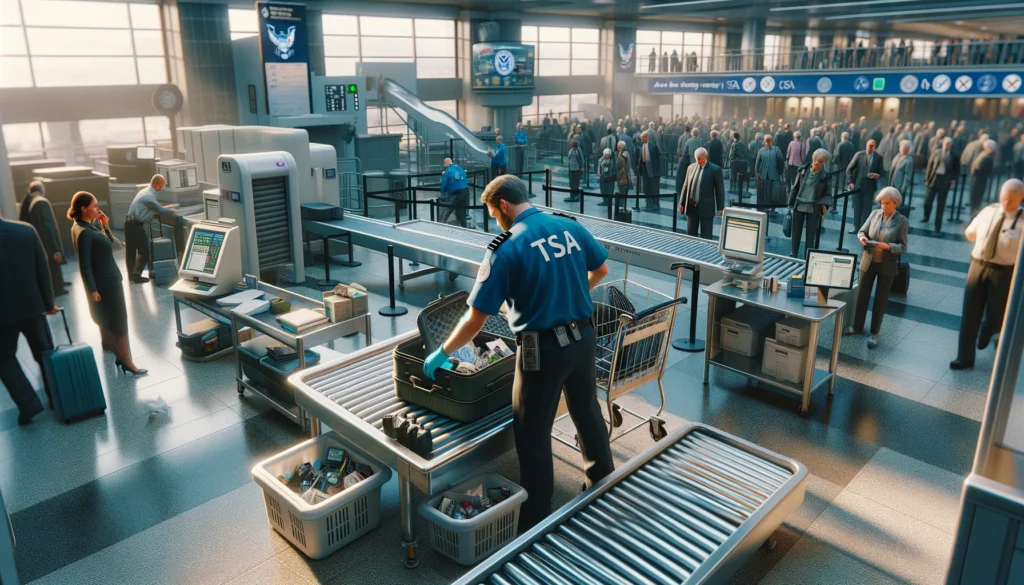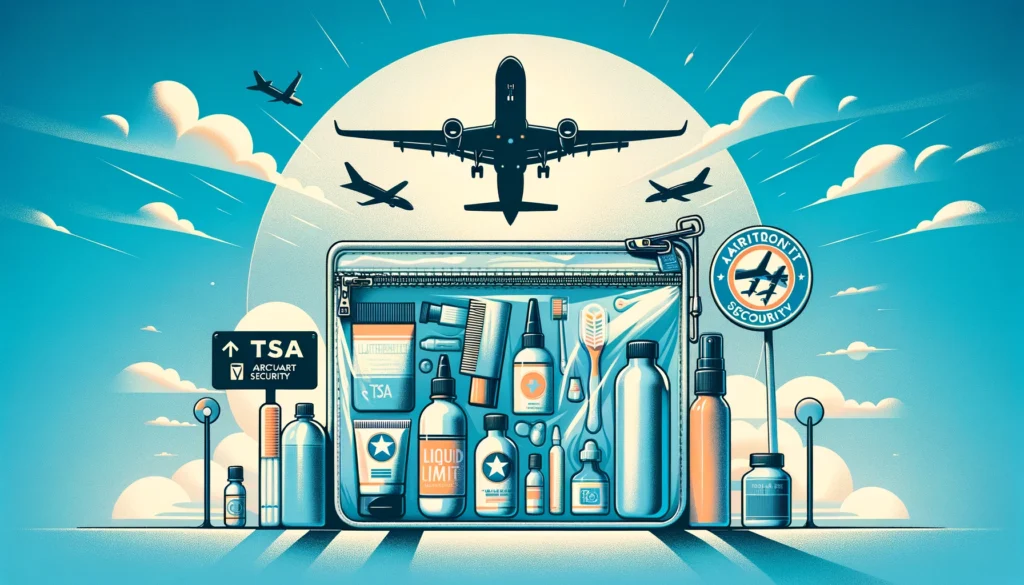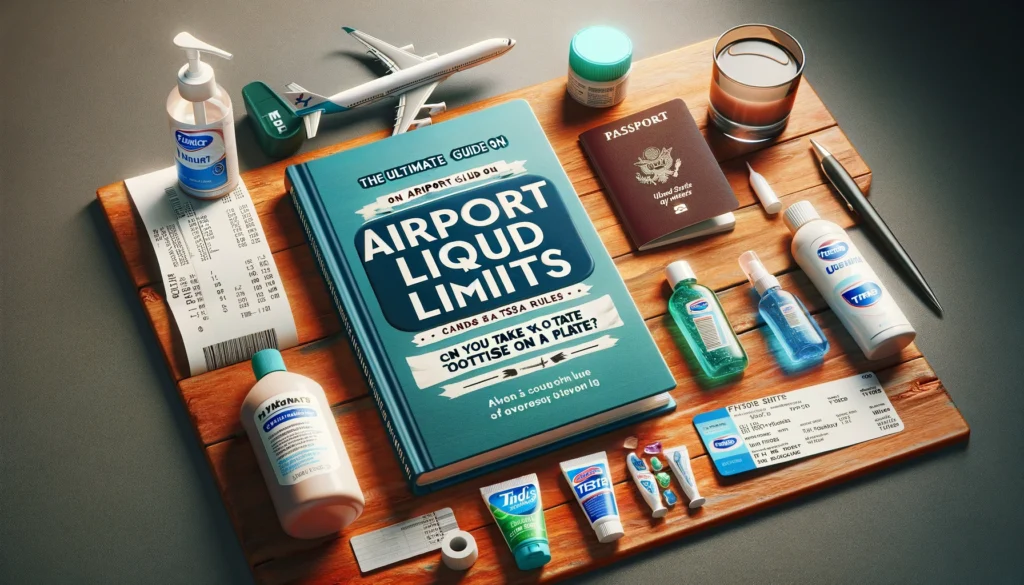Air travel involves many planning and packing steps. There is a routine that seasoned flyers perform – mostly they unpack, dispose, and repack their stuff to get their flight clearance. However, it is the distinction between what is acceptable and what is not.!! This dilemma has been brought to our attention regarding hygiene items like toothpaste on a plane.
We will do a detailed examination of what you should know before putting your toothpaste in the carry-on luggage, & also knowledge about TSA rules about other daily-use products, offering not only updates on the latest TSA rules but also some handy tips for keeping you safe from security-related frustrations.
We will not only answer & clear your query about toothpaste on a plane & TSA rules, discuss the main reasons behind the limits, suggest space-friendly alternatives, and guide you through the exact steps.
Navigating Liquid Limits and TSA Guidelines:
Understanding the TSA’s “3-1-1” Rule is essential for any traveler determined to avoid airport security holdups. This Rule consists of these “three” key numbers:
- 3: Each liquid must be in a container of no more than 3.4 ounces (roughly 100 ml).
- 1: All these containers must fit comfortably in a single, clear, resealable 1-quart bag.
- 1: One quart-sized resealable bag is allowed per traveler.
These parameters are critically important, as failure to comply can result in delays, confiscation of items, or even needing to repack your luggage right at the gate. With its generally larger tubes and questionable consistency, toothpaste frequently falls under scrutiny. But before we explore how to handle toothpaste in this security check, let’s examine why the Rule exists.

Reason Behind the Restriction on Toothpaste on a Plane & Other Liquids:
The 3-1-1 Rule came as a result of a coordinated terrorist attempt in 2006, which showed that terrorists could use liquid explosives to destroy airplanes in mid-air. The clear and present danger that liquids pose to air travel safety has been realized worldwide.
As a result, different governments and airports have put measures to limit the amount of liquids passengers can on board.
Additionally, screening the smaller volume of liquids accelerates the overall process. Such a system helps to prevent long delays as the containers can be scanned, but the flow of the goods will continue.
Safety and security are of utmost priority, which counts for all the people traveling from the USA to the UK, Australia & Other foreign countries. That’s why compliance with TSA recommendations and knowledge of their consequences for the journey is necessary.
Avoid TSA Delays During Security Checks:

Despite your best efforts, slipping up on the liquid front is easy. Here are some common mishaps to avoid:
- Overpouring: Double-check the ounces on your toothpaste container. Travel-sized doesn’t mean TSA accepted it if they are within their limits.
- Material Mistakes: The type of container matters too. Always use leak-proof containers to prevent accidental spills and subsequent disposal by TSA.
- Extra Care for Elderly and Young Flyers: If you’re traveling with someone needing more significant amounts of liquid (like prescription toothpaste on a plane), remember to adhere to TSA’s special needs provisions, such as notifying security and presenting medical documentation if necessary.
TSA Guidelines & Packing Tips For Daily-Use Products:
| Category | Item | TSA Guideline | Packing Tips |
| Liquids, Gels, Aerosols, Creams, and Pastes | Toothpaste, shampoo, conditioner, lotion, sunscreen, etc. | Must be in containers of 3.4 ounces (100 milliliters) or less per item. All containers must fit comfortably in a single, clear, quart-sized, zip-top bag. Just One bag is allowed per passenger in the carry-on bag. | Use travel-sized containers to save space. Consider solid alternatives like (bar soap, and solid shampoo) to bypass liquid restrictions. |
| Medications | Prescription and over-the-counter medications, including liquid medications | Permitted in reasonable quantities exceeding 3.4 ounces. Not required to be in the zip-top bag, but must be declared for inspection at the checkpoint. | Keep medications in their original packaging. Carry a copy of your prescription for controlled substances and injectables. |
| Baby Formula/Food, Breast Milk | Baby formula, breast milk, and juice for infants or toddlers | Exempt from the 3.4-ounce limit. Must be declared to a TSA officer for inspection. Containers may need to be opened for additional screening. | Pack only the amount you will need for the flight and the immediate period after landing to simplify screening. |
| Electronics | Laptops, tablets, e-readers, and large electronics | Must be removed from their bags and placed in a bin for X-ray screening. Smaller electronics like smartphones can remain in your carry-on. | Use a dedicated electronics compartment in your carry-on for easy access. Charge devices in case a power-on check is required. |
| Food | Solid food items, snacks, and sandwiches | Can be transported in either your carry-on or checked bags. Liquid or gel food items larger than 3.4 oz are not allowed in carry-on bags and should be placed in checked bags if possible. Food items may require additional screening. | Pack foods in clear plastic bags to facilitate screening. Consider packing snacks that cause less mess and are easy to eat. |
| Powders | Powder-like substances (e.g., coffee, spices, powdered milk) | 12 oz (350 ml) or larger powders must be placed in a separate bin for X-ray screening. They may require additional screening and containers may need to be opened. | Pack larger quantities in checked luggage to avoid delays. If carrying on, store in easily accessible containers. |
| Sharp Objects | Scissors (less than 4 inches), disposable razors, and nail clippers | Most sharp objects are prohibited in carry-on bags but may be allowed in checked bags if securely wrapped to prevent injury to baggage handlers and inspectors. Small scissors and disposable razors are allowed in carry-on. | Pack any necessary sharp objects in checked luggage. Ensure they are securely wrapped to avoid injury. |
| Tools | (less than 7 inches), screwdrivers, wrenches, and pliers | Tools shorter than 7 inches are permitted in carry-on bags but must be securely wrapped or sheathed to prevent injury. Longer tools must be checked. | If you must travel with tools, opt for compact versions that meet TSA guidelines and store them in checked baggage when possible. |
| Sporting Goods | Sports equipment like bats, golf clubs, and hockey sticks | Generally prohibited in carry-on luggage but can be transported in checked bags. | Consider renting equipment at your destination or ensure they are securely packed in your checked luggage. |
| Firearms and Ammunition | Guns, gun parts, realistic replicas | All types of Firearms and ammunition are prohibited in carry-on baggage but may be transported in checked bags if unloaded, packed in a hard-sided container, and declared to the airline at check-in. | Follow all airline and TSA regulations for transporting firearms and ammunition, including proper packaging and declaration. |
The Most Frequent Mistakes We Do While Packing Toothpaste While Going For A Flight:
It may be hard to believe that a single item like toothpaste could ignite debates in the travel industry, yet many travelers make the same mistakes when packing it for a flight. Here are some things you should avoid:
- Forgetting the 3-1-1 Rule: Most people forget about this rule, or even don’t know about it. This is one of TSA liquids regulations that limits carry-on baggage containers to sizes of 3.4 ounces or less per passenger, so you should remember this while packing a plane journey.
- Assuming all toothpaste is created equal: Not all kinds of toothpaste are sold in 3.4-ounce size, but they may still be branded as “Safe for travel”. Look at a care label for each item and pay attention to the size before putting them in your suitcases.
- Not considering resealable bags: To make your security screenings less bumpy during flight security checks, try putting toothpaste and other liquids in a transparent 1-quart bag and cleanly present it to the checkpoint point.
- Packing toothpaste in baggage without proper protection: If doing that is acceptable to you, you must think again, as this can result in unwanted aftershocks. To avoid it, even a security check you must have to keep your toothpaste in a Ziploc bag to prevent the undesired breakdown of your belongings because of leakage or spillage.
Tips for Packing Toothpaste and Liquids For Travel:

When the goal is to keep your smile gleaming without turbulence, here’s the step-by-step checklist to take toothpaste on a plane through security clearance
- Check the Expiry Date: Expired or near-expiry items may be discarded by TSA agents.
- Consolidate in Your Clear Bag: Ensure your toothpaste and other liquids are visible and easily accessible.
- Coordinate with Other Items: Position your toiletries bag to be inspected separately from other carry-on items for a hassle-free pat-down, if required.
- Follow the 3-1-1 Rule to the Letter: One bag, 3.4 ounces or less container size, and one bag per passenger.
- Be Clear about Containers: Are the containers transparent or opaque? Clarity here is critical to compliance.
- Demonstrate You’re Knowledgeable: The TSA should honor a confident, polite request for a manual inspection if your toothpaste needs to be recognized.
- Enjoy Your Flight: Knowing you’ve adhered to regulations means one less thing to worry about on your journey! Safe travels!
Pro Tips for a Stress-Free Airport Experience:
In other words, our blog post is a pro tip for a stress-free airport experience article.
- Plan Ahead: Get acquainted with the TSA rules on restricting liquids and the regulations from your airline. That will save not only your precious time but also your stress now at the airport.
- Pack Strategically: Keeping the quart-sized bag of liquids in sight and within easy access at the top of your carry-on will simplify removal during any necessary screening.
- Invest in Travel-Sized Products: To avoid exchanging travel-sized toothpaste with a tube that is 3.4 ounces or less, which, in turn, will exempt you from the confusion or hassle of returning with unsearched paste. That will comply with TSA requirements; you could pack it quickly into a quart-sized designated for liquids.
- Consider Alternative Oral Care Options: For packing toothpaste, go for alternatives such as tooth powder or chewable tablets, which are not water-related and, therefore, don’t count under the liquid restriction.
- Be Mindful of Special Needs: If you are traveling with someone who may require higher volumes of liquid (for example, prescription toothpaste), then be sure to carry the relevant documentation that will probably be needed by security to dispel doubts.
“Don’t give up, though, for those steps just mean that you are becoming closer and closer to creating that perfect smile that you can be proud of!”
Toothpaste on a Plane: Frequently Asked Questions
Is it Allowed to Take an Empty Bottle or a Tube on a flight?
Yes, you can carry the empty container as liquids on a plane or empty toothpaste on a plane. Empty bottles are exempted from the rigorous specifications and requirements targeted at fluid bottles. You can also keep your bottle refilled at water dispensers once you pass through the security checkpoint; thereby, you will stay hydrated during the flight without shelling out money to purchase expensive bottled water at the airport.
How much liquid can you bring to a plane?
When passengers enter or leave most countries, including the United States, they cannot carry liquids in containers exceeding 100 milliliters or 3.4 ounces. Such containers should be able to fit into the provided clear quart-size resealable bag. Each flight attendant allocates one bag per passenger. This Rule is called the 3-1-1 liquid rule, a directive set by the Transportation Security Administration (TSA), which manages security procedures.
What Is the Reason for the Liquid Limit?
The restriction on the liquid amounts & large-size toothpaste on a plane is more often for security purposes. Enacted in 2006, this measure prevents the possibility of thicker explosive liquids being carried onboard planes in larger volumes. By limiting the volume of liquids, gels, and aerosols, which is considered a safe amount, security agencies can manage potential threats more effectively and ensure that all passengers on the flight are secure.
What Is the Best Way to Travel with Toothpaste? Or How Can I Avoid Difficulties with Toothpaste on My Trip?
Toiletries restrictions are the regulations on liquids, which you can use traveling with a travel-sized tube that contains 3.4 ounces (100 milliliters) or less. It is the best way as it is the first-ever convenient way to pack everything in one modular unit. This container size fits TSA 3-1-1 liquid rule requirements and can be placed in the ziptop 3.4-ounce bag along with your other liquids. If you are going to stay longer during your trip, think about buying a giant toothpaste tube when you arrive at your destination or try to use solid toothpaste tablets, which are different from the restrictions that liquids have.
Can I Squeeze a 5-ounce Toothpaste Tube on a Flight to Meet the 3.4-ounce Limit?
No, a 5-ounce tube does not pass the plane security. If you try to reduce its apparent content beyond the allowed 3.4 ounces, squeeze its tube without favors. That is the only fundamental difference between the 3-1-1 liquid rules defined by TSA – the size of the container, not the volume; whatever amount of liquids is inside containers up to 100 ml is allowed.
For ‘baggage’, all the ‘tusk-tusk’, such as ‘liquids’, ‘gels’, and ‘aerosols’, must be in containers of not more than 3.4 ounces (100 milliliters), regardless of currently the ‘tusok-tusok’s’ fullness. It is most advisable to conclude with travel tickets marked as 3.4 ounces (100 milliliters) or less. Labeled as such, which makes compliance with the airport regulations, you would want to pass the security without inconveniences.
How Much Toothpaste Can I Take in the Airplane?
Thus, to comply with the airline liquid law, during flight, the toothpaste must not exceed 3.4 ounces, which is the equivalent of 100ml. This regulation is in place to make sure that passengers carry their necessary sanitary items without violating the set security standards.
Concerning my toothpaste, is there a particular flight liquid limit I should know?
Indeed, the liquid limit for the handbag, as per TSA’s 3-1-1 Rule, applies to toothpaste. Your toothpaste container should be at most 3.4 ounces and stored in a quart-sized liquid bag for carry-on luggage.
Can you take toothpaste on a plane without issues?
Yes, toothpaste can be taken on an airplane without problems if the TSA’s liquid limitation is adhered to. Having a checklist and conformity to these guidelines guarantees the process of checking in at security will proceed smoothly.
Can I take toothpaste with me in my handbag?
Absolutely. You can only have toothpaste on a plane in your carry-on bag if it adheres to the liquid size restrictions of TSA (Transportation Security Agency), which is 3.4 ounces or 100ml threshold.
What are the TSA liquid limits and size restrictions for carry-on liquids?
The TSA rule about the liquid Limit means that all liquids, gels, creams, and pastes, such as toothpaste, must be carried in containers with a volume of 3.4 ounces (100ml) or less per item. These things should snuggly fit in a transparent resealable bag of one quart. Passengers are all granted one of these bags in their carry-on luggage.
What Size of Toothpaste Can I Bring on the Airplane?
The airline liquid limit prescribes that any toothpaste on a plane shouldn’t overpass 3.4 ounces (100ml). This regulation guarantees travelers to have their essential toiletries without violating security rules.
Can I Take My Favorite Toothpaste on a Plane?
It can be used both as a carry-on and checked bag. When it comes to a carry-on, always ensure it meets the TSA’s liquid size limitations to avoid any hassles at the checkpoint.
Some Final Thoughts About Toothpaste on a Plane:
At first sight, toothpaste on a plane may seem more or less like one of the unimportant factors when it comes to air travel. Despite that, compliance with TSA rules ensures a pleasant trip for all travelers. Knowing how the system works and using a clever way of packing will help you have clean teeth and fresh breath wherever you go. So do pack smartly so that you have an enjoyable trip. Thus, you should be well versed with TSA regulations and do your planning in advance while packing liquids for air travel. These tips and preventing blatant errors will enable you to use the airports conveniently with your mouth smelling fresh.
Happy travels! Therefore, think carefully and travel safely!
References:
- Transportation Security Administration (TSA). Liquids rule. Retrieved from https://www.tsa.gov/travel/security-screening/liquids-rule
- US Department of State. (2019, October 17). Traveling with liquids and gels. Retrieved from https://travel.state.gov/content/travel/en/international-travel/before-you-go/travelers-with-special-considerations/Traveling-With-Liquids-and-Gels.html
- World Health Organization (WHO). (2018, March 1). Oral health. Retrieved from https://www.who.int/news-room/fact-sheets/detail/oral-health
- There are notable exceptions and provisions for those traveling with medical conditions or infants. It’s essential to familiarize yourself with these guidelines before packing your toothpaste.
Disclaimer:
The information provided here is for general reference purposes only and should not be considered a substitute for professional medical or legal advice. Always consult your healthcare provider and review official airline guidelines before traveling to ensure compliance and safety regarding personal care products.

